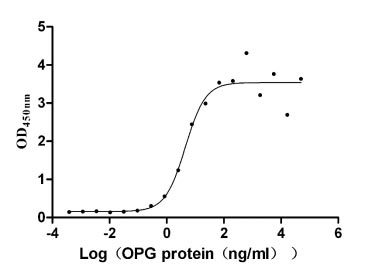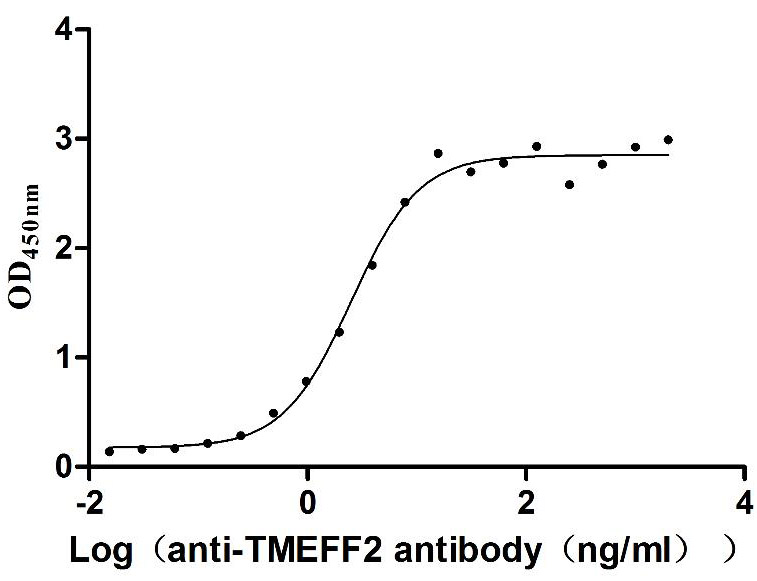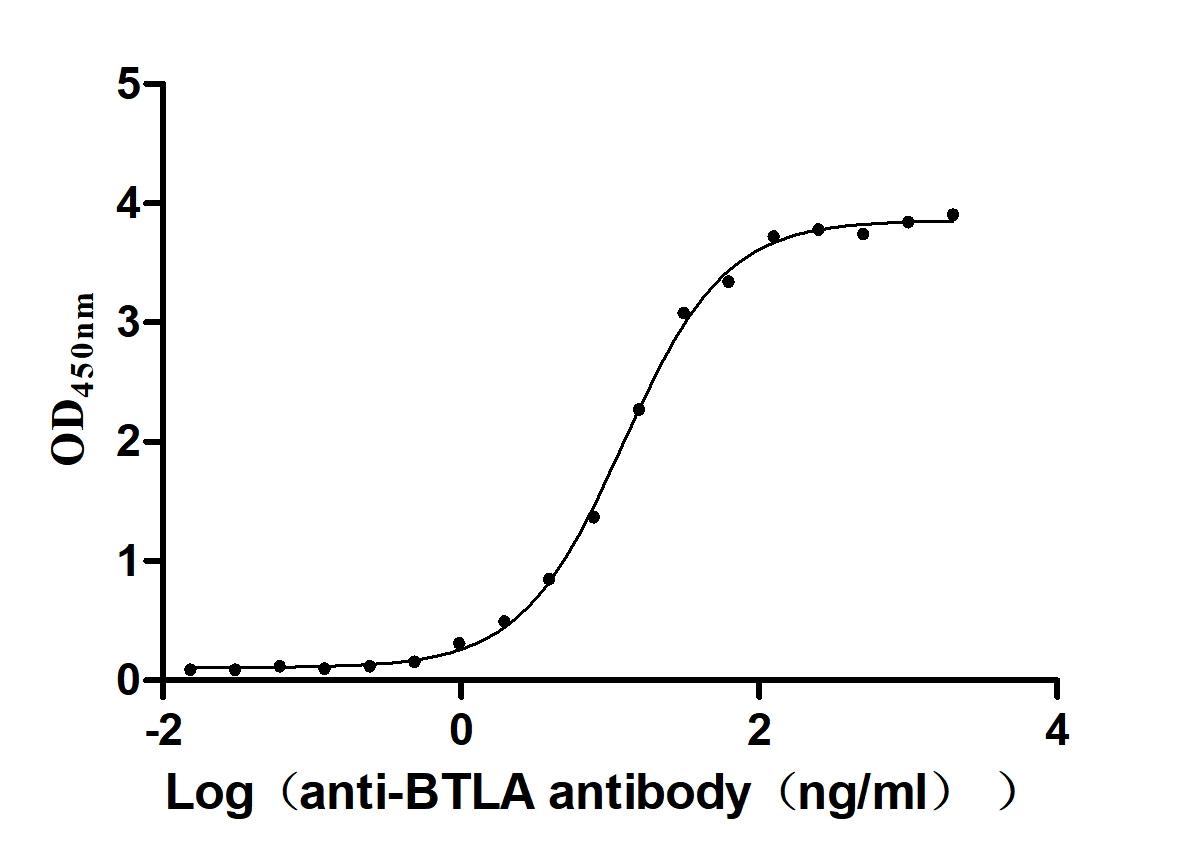Recombinant Mouse Tumor necrosis factor receptor superfamily member 9 (Tnfrsf9), partial
-
货号:CSB-YP023984MO1
-
规格:
-
来源:Yeast
-
其他:
-
货号:CSB-EP023984MO1
-
规格:
-
来源:E.coli
-
其他:
-
货号:CSB-EP023984MO1-B
-
规格:
-
来源:E.coli
-
共轭:Avi-tag Biotinylated
E. coli biotin ligase (BirA) is highly specific in covalently attaching biotin to the 15 amino acid AviTag peptide. This recombinant protein was biotinylated in vivo by AviTag-BirA technology, which method is BriA catalyzes amide linkage between the biotin and the specific lysine of the AviTag.
-
其他:
-
货号:CSB-BP023984MO1
-
规格:
-
来源:Baculovirus
-
其他:
-
货号:CSB-MP023984MO1
-
规格:
-
来源:Mammalian cell
-
其他:
产品详情
-
纯度:>85% (SDS-PAGE)
-
基因名:
-
Uniprot No.:
-
别名:Tnfrsf9; Cd137; Ila; Ly63; Tumor necrosis factor receptor superfamily member 9; 4-1BB ligand receptor; T-cell antigen 4-1BB; CD antigen CD137
-
种属:Mus musculus (Mouse)
-
蛋白长度:Partial
-
蛋白标签:Tag type will be determined during the manufacturing process.
The tag type will be determined during production process. If you have specified tag type, please tell us and we will develop the specified tag preferentially. -
产品提供形式:Lyophilized powder
Note: We will preferentially ship the format that we have in stock, however, if you have any special requirement for the format, please remark your requirement when placing the order, we will prepare according to your demand. -
复溶:We recommend that this vial be briefly centrifuged prior to opening to bring the contents to the bottom. Please reconstitute protein in deionized sterile water to a concentration of 0.1-1.0 mg/mL.We recommend to add 5-50% of glycerol (final concentration) and aliquot for long-term storage at -20℃/-80℃. Our default final concentration of glycerol is 50%. Customers could use it as reference.
-
储存条件:Store at -20°C/-80°C upon receipt, aliquoting is necessary for mutiple use. Avoid repeated freeze-thaw cycles.
-
保质期:The shelf life is related to many factors, storage state, buffer ingredients, storage temperature and the stability of the protein itself.
Generally, the shelf life of liquid form is 6 months at -20°C/-80°C. The shelf life of lyophilized form is 12 months at -20°C/-80°C. -
货期:Delivery time may differ from different purchasing way or location, please kindly consult your local distributors for specific delivery time.Note: All of our proteins are default shipped with normal blue ice packs, if you request to ship with dry ice, please communicate with us in advance and extra fees will be charged.
-
注意事项:Repeated freezing and thawing is not recommended. Store working aliquots at 4°C for up to one week.
-
Datasheet :Please contact us to get it.
相关产品
靶点详情
-
功能:Receptor for TNFSF9/4-1BBL. Possibly active during T cell activation.
-
基因功能参考文献:
- m4-1BBL and Gal-9 act together to aid aggregation of m4-1BB monomers to efficiently initiate m4-1BB signaling. PMID: 29242193
- the CD137-CD137L pathway plays an important role in regulating VSMC phenotype transformation via activation of NFATc1 signaling pathway. PMID: 28770466
- Tonic 4-1BB costimulation in chimeric antigen receptors impedes T cell survival and is vector-dependent. PMID: 28978471
- fatty acid metabolism plays a crucial role in enhancing the cell cycle progression of anti-CD3-activated CD8(+) T cells in vitro and the anti-apoptotic effects of 4-1BB signaling on these cells. PMID: 26972770
- CD137 signaling activates the pro-angiogenic Smad1/5 pathway, induces the phosphorylation of Smad1/5 and nuclear translocation of p-Smad1/5, which in turn promotes the expression and translocation of NFATc1. Blocking CD137 signaling with inhibitory anti-CD137 antibody could inhibit this activation and attenuated agonist anti-CD137 antibody-induced angiogenesis. PMID: 28288971
- the role of CD137-CRDI (cysteine rich domain I) in the binding of CD137-CD137L was further investigated. PMID: 27430526
- Data indicate that anti-CD137 agonists can function as inhibitors of CD137L signaling, resulting in the creation of tumor microenvironments unfavorable for tumor immune evasion. PMID: 28923858
- This study discovers the 4-1BB pathway signaling enhances inflammatory response and promotes pulmonary fibrosis induced by crystalline silica. PMID: 27698940
- Constitutive interaction between 4-1BB and 4-1BBL on murine LPS-activated bone marrow dendritic cells masks detection of 4-1BBL by TKS-1 but not 19H3 antibody. PMID: 28789924
- results indicate that one important diabetogenic function of CD137 is to promote the expansion and accumulation of beta cell-autoreactive CD8 T cells, and in the absence of CD137 or its interaction with CD137 ligand, type 1 diabetes progression is suppressed PMID: 28363905
- High CD137 expression is associated with neoplasms. PMID: 28082401
- Ly6C, 4-1BB, and KLRG1 have roles in the activation of lamina propria lymphocytes in the small intestine in a mouse model of Crohn's disease PMID: 28011265
- CD137 Regulates NFATc1 Expression in Mouse VSMCs through TRAF6/NF-kappaB p65 Signaling Pathway. PMID: 26600673
- 4-1BB triggering preferentially enhances the expansion of CD8+ T cells through the amplification of autocrine IL-2/IL-2R signaling loop. PMID: 25962156
- c-IAP ubiquitin protein ligase activity is required for 4-1BB signaling and CD8(+) memory T-cell survival. PMID: 26096449
- we conclude that in vivo 4-1BB signaling of myeloid cells negatively regulates peripheral T cell responses PMID: 25601928
- activation of CD137 signaling decreases the stability of advanced atherosclerotic plaques via its combined effects on Teff cells, vascular smooth muscle cells, and macrophages PMID: 25059229
- 4-1BB mediates the inflammatory responses in obese skeletal muscle by interacting with its ligand 4-1BBL on macrophages. PMID: 24453430
- CD137-CD137L interactions mediated via regulation of CyPA contribute to the progression of atherosclerosis. PMID: 24520398
- action of agonist anti-4-1BB in suppressing autoimmune and allergic inflammation was completely dependent on Galectin-9 (Gal-9). Gal-9 directly bound to 4-1BB, in a site distinct from the binding site of antibodies and the natural ligand of 4-1BB PMID: 24958847
- sCD137 can actively suppress highly purified CD4 T cells in a CD137L dependent fashion. PMID: 24145149
- monocytes interact with iNKT cells to increase expression of 4-1BBL and 4-1BB, and in conjunction with this pathway, maintain their numbers at baseline. PMID: 24639347
- 4-1BB signaling enhances the proliferation of activated CD8(+) T cells. PMID: 23874982
- Results found the activation of CD137L reverse signaling by CD137 resulted in a decrease in cell adhesion to the fibronectin-coated culture basement, thus causing detachment-induced cell death. PMID: 23925549
- CD137 plays an essential role in the resolution of acute DSS-induced intestinal inflammation in mice PMID: 24023849
- During CD134 plus CD137 dual costimulation, IFN-gamma interacts with IL-2 through distinct mechanisms to program maximal expression of effector molecules in antigen-responding T-cells. PMID: 23295363
- Sjogren's syndrome-like autoimmune sialadenitis in MRL-Faslpr mice is associated with expression of glucocorticoid-induced TNF receptor-related protein (GITR) ligand and 4-1BB ligand. PMID: 23301790
- Taken together, these data provide evidence that the 4-1BB signal is an important regulator of gammadelta T cells PMID: 23640752
- CD137-CD137L interactions increase myelopoiesis during infection PMID: 23519951
- 4-1BB/4-1BBL-mediated bidirectional signaling in adipocytes/macrophages promotes adipose inflammation. PMID: 23316108
- TRAF1 and LSP1 cooperate downstream of 4-1BB to activate ERK signaling and down-modulate the levels of Bim leading to enhanced T cell survival. PMID: 23446150
- The CD137 receptor/ligand system may be a mediator of neuroinflammatory and neurodegenerative disease, by activating microglia which in turn kill oligodendrocytes. PMID: 22799524
- Systemic 4-1BB activation induces a novel T cell phenotype driven by high expression of Eomesodermin. PMID: 23547098
- 4-1BB signaling plays a role in activating maternal CD8+ T cells from their hypo-responsiveness that are reactive with allogeneic fetal tissue and probably with conventional antigens. PMID: 23029041
- CD137L regulates many functions of myelin oligodendrocyte glycoprotein-specific T-cells that contribute to Experimental autoimmune encephalomyelitis PMID: 23238738
- After stimulation of total mononuclear cells or CD4+ T cells, surface expression of 4-1BB can be used to detect activated Foxp3+ regulatory T cells (Treg) within a defined window. PMID: 23162126
- Results indicate that 4-1BBL/4-1BB contributes to cell survival during antigen-independent IL-2/mAb-complex-dependent T-cell expansion. PMID: 21946662
- Data indicate that hypoxia as sensed by the HIF-1alpha system increases expression of CD137 on tumor-infiltrating lymphocytes that become selectively responsive to the immunotherapeutic effects of anti-CD137 agonist monoclonal antibodies. PMID: 22719018
- deficiency does not affect development of airway inflammation or respiratory tolerance induction PMID: 22519594
- CD137 has a role in breast cancer and its specific antibody can be used to enhance trastuzumab efficacy PMID: 22326955
- conditioned medium from Lewis Lung Carcinoma cells caused significant upregulation of 4-1BB in mast cells PMID: 22343053
- these data demonstrate that 4-1BB and 4-1BBL do not play a strong or dominant role in driving the generation of high frequencies of vaccinia virus -specific CD8 T cells. PMID: 22037570
- The findings suggest that 4-1BB and 4-1BBL may be useful therapeutic targets for combating obesity-induced inflammation and metabolic disorders. PMID: 21998397
- the therapeutic outcome of 4-1BB triggering is determined by whether the protective immunity generated against the virus was beneficially altered by the 4-1BB triggering. PMID: 21700476
- T-cell co-inhibitory blockade combined with alphaCTLA-4 and active co-stimulation with alpha4-1BB promotes rejection of B16 melanoma in with a vaccine; KLRG1 is a useful marker for monitoring the anti-tumor immune response elicited by this therapy PMID: 21559358
- the current study identifies for the first time a specific CD134 plus CD137 costimulatory pathway and an intracellular mechanism relying on Eomesodermin that induces cytotoxic CD4 Th1 cells PMID: 21880986
- Membrane and soluble forms of Tnfrsf9 are expressed in specific cell types of the uterus and conceptus during the progression of implantation in mice and possibly have an important function in this process. PMID: 21560035
- 4-1BB signaling seems to modulate autoimmune encephalitis by a number of mechanisms, and modulation of the T helper (Th)17 cell versus regulatory T cell (Treg) balance is one of those mechanisms. PMID: 21715692
- 4-1BB signaling synergizes with programmed death ligand 1 blockade to augment CD8 T cell responses during chronic viral infection. PMID: 21742975
- granulocyte and macrophage populations of murine bone marrow cells are regulated by G-CSF and CD137 protein PMID: 21179444
收起更多
-
亚细胞定位:Membrane; Single-pass type I membrane protein.
-
组织特异性:Expressed on the surface of activated T-cells.
-
数据库链接:
KEGG: mmu:21942
STRING: 10090.ENSMUSP00000030808
UniGene: Mm.244187




















